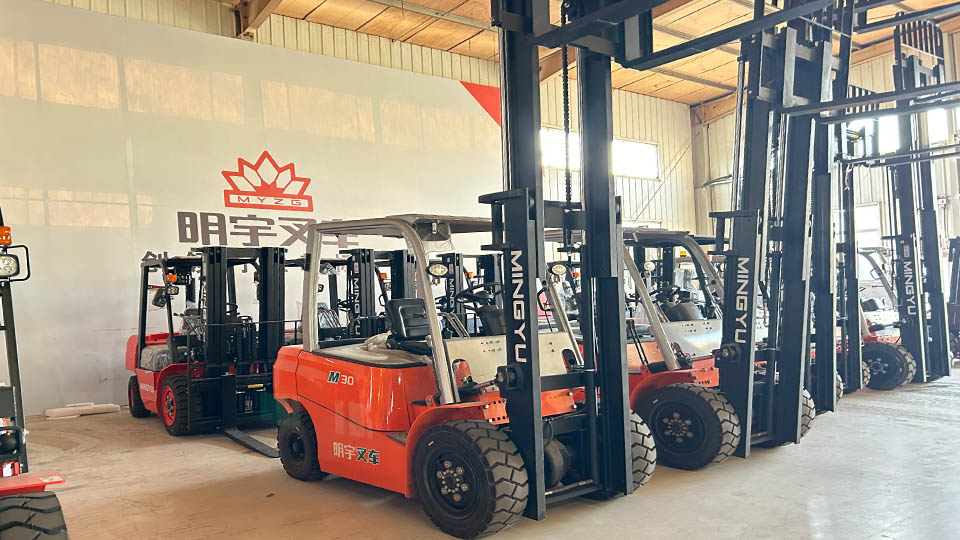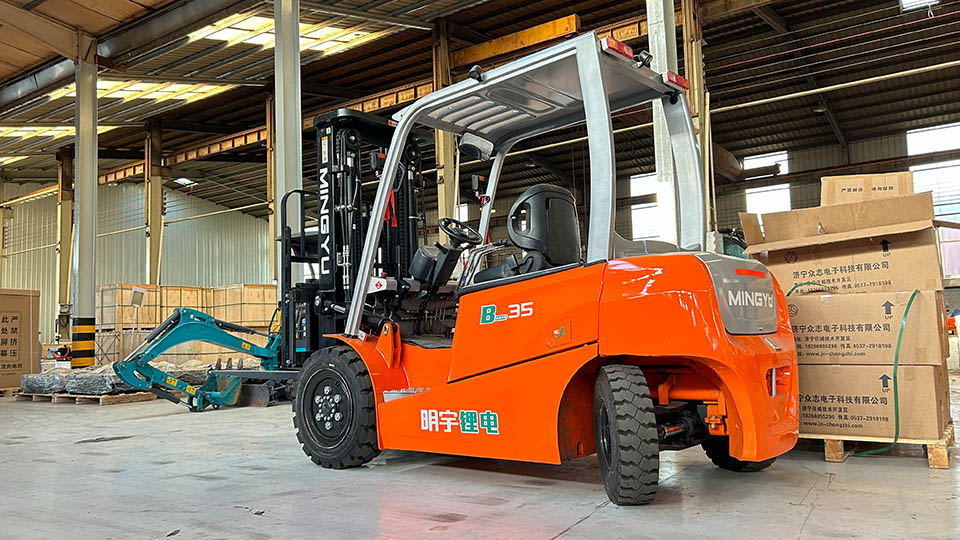
Can Electric Forklifts Go Outside? A Comprehensive Technical Analysis
Abstract: Electric forklifts are increasingly becoming the preferred choice for material handling due to their environmental benefits, lower operating costs, and reduced noise levels. However, a common misconception persists regarding their suitability for outdoor applications. This technical article delves into the capabilities and limitations of electric forklifts operating outdoors, examining critical factors such as IP ratings, battery technology, tire types, motor and controller protection, terrain considerations, temperature impacts, and maintenance requirements. It aims to provide a comprehensive understanding for businesses considering electric forklifts for their outdoor operations, offering insights into best practices and technological advancements that enable their effective deployment in various external environments.
1. Introduction
The rising dominance of electric forklifts in indoor material handling.
The persistent question: Are they truly viable for outdoor use?
Briefly introduce the key factors that determine outdoor suitability (IP ratings, battery, tires, environmental conditions).
Thesis statement: Electric forklifts can go outside, but their effectiveness and longevity depend on careful selection, configuration, and operational considerations.
2. Understanding the Challenges of Outdoor Operation for Electric Forklifts
Environmental Exposure:
Moisture: Rain, snow, sleet, puddles, humidity.
Dust and Debris: Fine particles, larger debris from construction, agricultural settings, or outdoor storage.
Temperature Extremes: High heat (summer sun, hot asphalt), freezing cold (winter, cold storage adjacent to outdoor areas).

Uneven Terrain: Potholes, gravel, slopes, uneven concrete.
UV Radiation: Degradation of plastics, hoses, and paint.
Operational Demands:
Longer travel distances compared to typical indoor routes.
Potentially heavier loads requiring more power.
Lack of consistent charging infrastructure outdoors.
3. Key Technical Considerations for Outdoor Electric Forklift Performance
3.1. Ingress Protection (IP) Ratings: The First Line of Defense
What are IP Ratings? Explain the two-digit system (first digit for solids, second for liquids).
Common IP Ratings for Forklifts:
IP54: Protection against dust and splashing water.
IP55: Protection against dust and low-pressure water jets.
IP65: Dust-tight, protected against low-pressure water jets.
IP66: Dust-tight, protected against strong water jets.
IP67: Dust-tight, protected against temporary immersion in water.
Importance for Outdoor Use: Why a higher IP rating is crucial for components like motors, controllers, battery compartments, and connectors.
Limitations of IP Ratings: They describe protection, not submersion tolerance. Emphasize that even high IP ratings don't mean a forklift is an amphibious vehicle.
3.2. Battery Technology and Management in Outdoor Environments
Types of Batteries:
Lead-Acid Batteries:
Pros: Mature technology, lower initial cost.
Cons: Sensitive to temperature extremes (reduced capacity in cold, accelerated degradation in heat), requires more maintenance (watering), longer charging times, off-gassing.
Outdoor considerations: Need for enclosed, well-ventilated charging areas; temperature management during operation.
Lithium-Ion (Li-ion) Batteries:
Pros: Higher energy density, faster charging, opportunity charging capable, less sensitive to temperature variations (often with integrated thermal management systems), no off-gassing, longer lifespan, virtually maintenance-free.
Cons: Higher upfront cost.
Outdoor considerations: Excellent choice due to robust nature, integrated BMS (Battery Management System) for thermal control.
Battery Enclosures: The importance of sealed, robust battery compartments, especially for Li-ion, to protect against moisture and debris.
Charging Infrastructure Outdoors: Considerations for protected charging stations, weatherproof outlets, and temperature-controlled charging environments.
3.3. Motors and Controllers: Powering Through the Elements
Enclosed vs. Open Motors: Emphasize the necessity of fully enclosed AC motors (typically found in modern electric forklifts) for outdoor use, offering protection against dust and moisture.
Controller Protection: Controllers (the "brain" of the forklift) are highly sensitive. Discuss the importance of sealed, IP-rated enclosures for controllers and wiring harnesses.

Thermal Management: How motors and controllers dissipate heat, and how outdoor ambient temperatures can impact this. Advanced systems may have integrated cooling.
3.4. Tire Types: Traction and Durability on Varied Surfaces
Cushion Tires:
Suitable for: Smooth, indoor surfaces.
Unsuitable for: Uneven outdoor terrain, offer poor traction.
Solid Pneumatic Tires:
Characteristics: Solid rubber, puncture-resistant, mimic air-filled tires in shape.
Suitable for: Light to moderate outdoor use on relatively smooth concrete or asphalt, some gravel. Good stability.
Pneumatic Tires (Air-filled):
Characteristics: Air-filled, offer excellent shock absorption.
Suitable for: Rough, uneven outdoor terrain (gravel, dirt, potholes), provide superior traction and operator comfort. Most recommended for dedicated outdoor operations.
Tread Patterns: Importance of aggressive tread patterns for wet or loose surfaces.
3.5. Corrosion Resistance and Material Selection
Chassis and Components: Use of rust-resistant coatings, galvanized steel, or stainless steel in critical areas.Wiring and Connectors: Waterproof and corrosion-resistant wiring, sealed connectors to prevent shorts and signal degradation.Hoses and Seals: UV-resistant and weather-resistant hydraulic hoses and seals.
3.6. Operator Compartment and Visibility
Canopies and Enclosed Cabs: Protection from sun, rain, and cold. Heaters and air conditioning options for extreme temperatures.
Lighting: Adequate LED lighting for low-light conditions, especially in outdoor settings with less ambient light.
Wipers and Washers: Essential for maintaining visibility in rain or dusty conditions.
4. Operational Best Practices for Outdoor Electric Forklifts
Pre-Operation Checks: Thorough inspection for damage, tire pressure, battery charge, and cleanliness.
Route Planning: Avoiding large puddles, extremely rough terrain, and steep, slippery slopes.
Charging Strategy: Ensuring reliable, weather-protected charging stations. Implementing opportunity charging for Li-ion batteries.
Cleaning: Regular cleaning to remove dirt, salt, and corrosive materials, especially after exposure to harsh weather.
Operator Training: Educating operators on the limitations of electric forklifts outdoors, safe operating procedures in varying weather conditions, and proper charging protocols.
Storage: Parking forklifts in a protected, dry area when not in use, especially overnight.
5. Environmental Impact and Cost Benefits in Outdoor Applications
Reduced Emissions: Zero tailpipe emissions, contributing to cleaner outdoor air.
Lower Noise Pollution: Significant advantage in residential areas or noise-sensitive outdoor environments.
Operating Cost Savings: Lower fuel costs (electricity vs. propane/diesel), reduced maintenance compared to IC trucks (fewer moving parts, no oil changes, spark plugs, etc.).
Total Cost of Ownership (TCO): Highlighting how the initial investment in a robust outdoor-spec electric forklift can be offset by long-term savings.
6. Limitations and Scenarios Where IC Forklifts May Still Be Preferred
Extreme Cold: While Li-ion is better, prolonged operation in extremely sub-zero temperatures (e.g., -20°F / -29°C) might still pose challenges for any battery.
Very Rough Terrain: Exceptionally challenging, unmaintained, or deeply muddy terrain might still favor specialized IC rough-terrain forklifts with robust suspensions and extreme ground clearance.
Prolonged Operation Away from Charging Infrastructure: If continuous, multi-shift operation is required in remote outdoor locations without accessible charging points, IC might still be a temporary solution.
Very Heavy Duty, Continuous Outdoor Applications: For certain niche applications requiring extreme lifting capacities and continuous heavy-duty outdoor work without breaks for charging, IC might still hold a niche. However, this gap is rapidly closing with advanced electric models.
7. Conclusion
Reiterate that electric forklifts are increasingly capable of outdoor operation.
Emphasize the importance of selecting the right electric forklift for the specific outdoor application (IP rating, battery, tires).
Highlight the long-term benefits: environmental, cost-effective, and operational.
Future outlook: Continued advancements in battery technology, motor efficiency, and all-weather protection will further solidify the position of electric forklifts as versatile machines for both indoor and outdoor material handling.
References (Optional but Recommended):
Industry standards bodies (e.g., ISO, IEC for IP ratings).
Major forklift manufacturers' technical specifications.
Research papers on battery technology and thermal management.
Name: selena
Mobile:+86-13176910558
Tel:+86-0535-2090977
Whatsapp:8613181602336
Email:vip@mingyuforklift.com
Add:Xiaqiu Town, Laizhou, Yantai City, Shandong Province, China